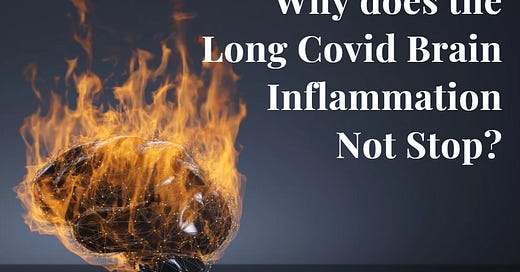Long Covid - A Neuroimmune Puzzle Waiting for a Macrophage Key
What is holding the neuroimmune inflammatory fire in place?
If you’ve followed the emerging science around long COVID, you may have seen a recent review by Moen et al. published in Psychiatry and Clinical Neurosciences (2025). The paper, titled “Neuroimmune Pathophysiology of Long COVID,” brings a welcome spotlight to the brain, immune system, and lingering symptoms that millions still struggle to understand—let alone treat.
Their central premise? Long COVID is not psychological. It is a neuroimmune disorder, marked by persistent inflammation, microglial overactivation, disrupted neurotransmitters, and possible autoimmune activity.
So far, so good.
But here's what stood out most: what the paper says—and what it doesn’t.
What the Moen Review Gets Right
Microglia (brain-resident macrophages) are persistently activated in long COVID, even in the absence of detectable virus.
Inflammatory cytokines like IL-6, IL-1β, and TNF-α are elevated, which are classic markers of immune system overdrive.
Tryptophan metabolism is altered, which may explain mood disorders, fatigue, and cognitive dysfunction ("brain fog"). This is largely because the immune system becomes more activated with tryptophan.
Autoantibodies against neuronal and receptor targets could help explain the strange and variable symptom profiles.
Persistent spike protein or RNA fragments may trigger chronic immune responses long after the infection is gone.
This is a landmark synthesis—and for many, it may appear complete.
But if you’ve been following our research, you’ll know we’ve been building a different kind of framework: one that places macrophage reprogramming and dysfunction at the very heart of long COVID.
The Missing Link: Macrophage Memory
What Moen et al. don’t address is why the immune system stays stuck in this hyperactive state. They describe what is happening—but not what’s sustaining it.
That’s where our upcoming paper offers a new paradigm.
Recent studies (like Simonis et al. 2025) have shown that monocyte-derived macrophages can become epigenetically reprogrammed after exposure to the spike protein—especially following mRNA vaccination. Through histone modifications (notably H3K27 acetylation), these cells can stay locked in a pro-inflammatory mode for months. Even when monocytes are replaced, this “trained immunity” can persist via myeloid progenitor imprinting.
This mechanism could explain:
Why microglia remain inflamed in the brainstem and cortex
Why peripheral monocytes harbor spike protein for up to 15 months
Why autoimmune cascades continue without viral replication
Why patients relapse after exertion or stress—macrophages flare first
In short: macrophages aren’t just participating—they’re driving the process.
Reframing the Brain: Microglia as the Rosetta Stone
Moen et al. describe microglia as central players in cognitive decline, autonomic instability, and neuroinflammation. But they don’t link these findings to the broader systemic macrophage network.
We do.
Our research connects:
CD16⁺ monocytes with spike protein persistence
Hypermetabolic lymphadenopathy post-vaccination, linked to macrophage priming
Brainstem symptomatology (e.g., breathlessness, dysautonomia) to macrophage clustering in key autonomic centers
Trained immunity and epigenetic lock-in, explaining duration and intensity of symptoms
This is the cohesive biological narrative that has been missing.
What Comes Next
In our forthcoming long COVID paper, we lay out this macrophage-centric framework in full—with references, mechanisms, and clinical implications. It’s a mosaic, and Moen et al. have placed some of the most critical tiles.
But the pattern only becomes clear once the macrophages are at the center.
The neuroimmune model of long COVID is real—and increasingly well supported. But the question remains:
Why doesn’t the immune system stand down?
Our answer: because it can’t. Not until the macrophages are reset.





I’m doing some work for publication related to brain inflammation if you want to chat about it.
Fascinating. Makes sense. What then?